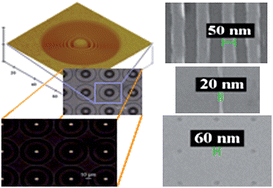Nanofabrication in cellulose acetate
Abstract
We have demonstrated nanofabrication with commercialized cellulose acetate. Cellulose acetate is used for bulk nanofabrication and surface nanofabrication. In bulk nanofabrication, cellulose acetate reacts with an e-beam and permanent patterns are formed in it instead of being transferred to other substrates. We have studied the nano relief modulation performance of cellulose acetate before and after development. The depth of the nanopatterns is magnified after development, and is varied by exposing dosage and line width of the pattern. The thinnest 65 nm wide line is achieved in the bulk fabrication. We also demonstrate a binary phase Fresnel lens array which is directly patterned in a cellulose acetate sheet. Because of its unique mechanical and optical properties, cellulose is a good candidate for a template material for soft imprinting


 Please wait while we load your content...
Please wait while we load your content...